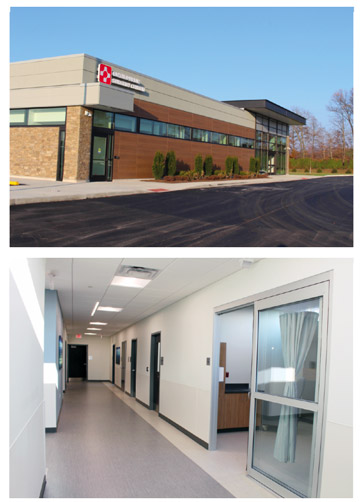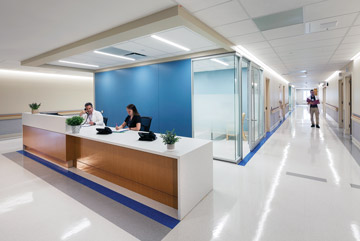Richard Evans, MD, vice president of surgical services at Bon Secours Charity Health System and member of the Westchester (N.Y.) Medical Center Health Network, says his health system’s Good Samaritan Hospital built an ortho-only surgical
facility to have a dedicated space where staff could focus on delivering care to total joints patients who, in turn, would benefit from single-specialty resources and a specialized staff’s expertise.
“Everyone has the same goal — achieving excellent outcomes,” says Dr. Evans. “Plenty of time to talk joints. Nurses all talk the same lingo and learn from each other about ways to improve patient care. Patients see other
patients ambulating after undergoing the same procedures, and are motivated to do the same. That has a significant impact on positive surgical outcomes.”
Mr. Cera and Dr. Evans shared some of their facilities’ features that were designed to enhance joint replacement outcomes, and improve patient and staff satisfaction.
- Build around the ORs. Breathtaking atriums and high-end finishes are nice and pack a patient-satisfying punch, but don’t lose sight of the space that matters most. Mr. Cera says his team dedicated enough square footage
to build healthy-sized ORs — the ORs in The Orthopaedic Surgery Center are 590 square feet, plenty big enough to house the equipment needed for total joints and, eventually, the spine service line the surgeons plan to add —
and built the rest of the facility around that money-making square footage responsible for meeting the facility’s return on investment.
Determining how many ORs to build or frame out for future use is one of, if not the most, important decisions you’ll make. When you’re spending $450 per square foot, difficult decisions need to be made. It demands finding the
sweet spot between forecasting future growth and working within the constraints of your current budget.
“Our new facility has 4 ORs, one more than we worked with previously,” says Mr. Cera. “Was it the right decision? We can’t be certain, but we’re currently working with more capacity than before and still have room
to grow.”
The Orthopaedic Surgery Center also built its pre-op and PACU areas within steps of the ORs to limit the walking distance for staff and how far patients have to be moved from one location to the next. Good Samaritan’s waiting room was built
close to the ORs, so surgeons can quickly shuttle between the spaces to update patient family members between cases. “Maintaining that efficient communication is important for everybody,” says Dr. Evans.
Both facilities added the latest advances in arthroscopy towers, 4K video technology and robotic arm-assisted technology, which is developing into a go-to tool for joint replacement surgeons that will set your facility apart from the competition
and outfit it for the future of joint replacement care.
- Add versatility. Maximizing the use of limited square footage demands focusing on the versatility and functionality of spaces. “Conversations with leaders at other new facilities and consultations with our healthcare
architect convinced us to include mobility whenever possible,” says Mr. Cera. “OR lights and equipment hang from booms to help us move it to where it’s needed and clean rooms between cases. Instead of building multiple
storage rooms that take up valuable real estate, we added mobile storage units in the corners of each OR.”
Streamlined facilities should build multi-use spaces to optimize efficiencies and maximize overall capacity. The Orthopaedic Surgery Center has 3 overnight suites used for a small percentage of 23-hour-stay patients who need extended recoveries.
They can be closed off with private doors or kept open during busy days as extra PACU space.
- Focus on instrument care. Mr. Cera says he and his surgeons made a concerted effort to invest in the sterile processing department, a space of critical importance in an instrument-heavy specialty such as orthopedics. They
wired the facility at 480 watts in part to accommodate a pair of automated instrument washers — replicate every piece of equipment, suggests Mr. Cera, because if one goes down, another is online, ready to go — with 25-minute
cycle times, an important factor to maintain an efficient schedule during a day involving instrument-heavy procedures
.
The washers feature the latest cleaning technology with capacities 2 times larger than the models in the group’s previous facility. Each joint replacement sends 7 to 9 instrument trays to central sterile for reprocessing. The large-capacity
washers help the reprocessing techs keep up with the heavy workload. “In an 8-hour day, the washers help us gain 3.25 hours of added efficiency,” says Mr. Cera.
- Help patients recover. Entrance and bathroom doors in private patient recovery rooms at Good Samaritan’s surgery center are 2.5 times wider than standard doorways, which are often difficult for recovering patients to
navigate on walkers. Each room is also equipped with digital monitoring equipment, which sends vital signs data to the facility’s electronic medical record for near real-time auditing by the clinical team. A communal dining area
is where all total joints patients must gather to eat, a factor that helps get them up and moving soon after surgery.
.svg?sfvrsn=be606e78_3)


.svg?sfvrsn=56b2f850_5)